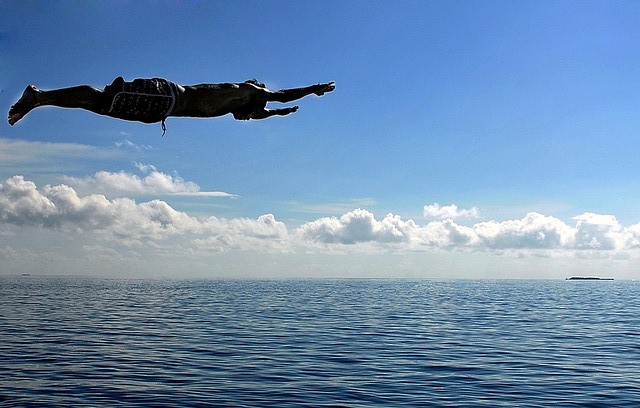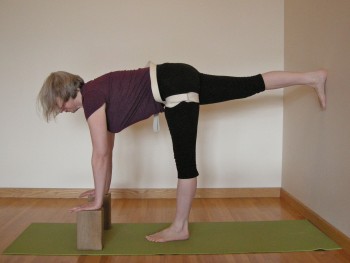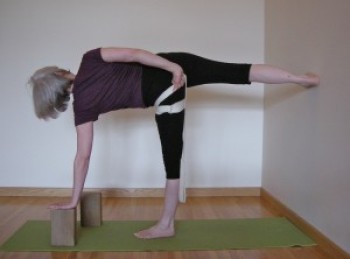The first time I lifted off in half-moon I was in a setup just like the one in the picture below, but without the belt.
At that moment, after months of mid-room struggle, I finally understood why yogis so often count this demanding balance pose among their favorites.
Between the wall at my foot and the brick under my hand, I had enough support to relax in the pose.
Then with arms and legs extending, spine lengthening, energy radiating in all directions, for a brief moment, I had a feeling of something familiar yet unexpected: the wingless soaring we do in our dreams.
No wonder half-moon (Ardha Chandrasana) reduces anxiety, along with menstrual pain, backache and indigestion.
When you come back to earth, you feel bigger, with a confidence born of having been at home in another element.
Beginners’ note: If you’re just starting to learn the pose, put your mat lengthwise against the wall, and have a brick for your hand. With your back to the wall, come up into the pose and let the wall support you. When you are stable enough to balance without touching the wall, you’re ready to try this tip.
Prop up and learn to fly.
For this piece of flight training, you need a wall, two bricks and a strap.
The wall is there to support your raised foot, and give you something to push into.
The bricks are there to make getting into the pose easier, and to keep the hamstring stretch moderate.
And the strap?
In order to take off in half-moon pose, you need a solid foundation. The thigh you’re standing on has to have a healthy, compact relationship with its hip socket.
Our natural tendency is to let the thighbone drop out to the side, creating a counter-balance and putting unhealthy pressure into our knees and ankles.
Instead, the thighbone needs to pull into the hip socket, the hip crease needs to rotate outward, and the front thigh needs to press toward the back thigh.
That’s not so easy to do. But with an outward rotating strap at your upper thigh, you can use your opposite hand to move your standing leg into place.
Here’s how to do it:
As in last week’s post on triangle pose, make a loop in a strap and bring the loop to the inside of your right thigh.
Thread the end of the strap through the loop and pull the strap to the right. Wrap it once more around your right thigh, creating a strong external rotation. Tuck the end of the strap into the left side of your waistband.
Place your sticky mat with the narrow end to the wall.
Have two yoga bricks.
Stand about the length of your leg away from the wall. Bend forward, bring your hands to the bricks and raise your right leg.
If you’re too close to the wall, you won’t be able to bring your leg up to the height of your pelvis.
If you’re too far from the wall, you won’t be able to press your whole foot into the wall.
Your right leg should be perpendicular to the floor, not angling back towards the wall.
Now lift your left hand from the brick, and rotate your right hip, thigh and pelvis to the right.
Check that your right foot is still straight. The standing leg foot often turns out to the right, which is the body’s artful way of reducing the work in the hamstrings.
If it has deviated, bring it back in line.
Then check that your left foot, now parallel to the floor, lines up with your right foot: left heel to the middle of the right arch.
Firm your right thigh, and press the front thigh deeper into the bone.
From your left buttock, extend toward your left heel, pushing the heel into the wall.
Reach your left hand back and take hold of the strap. Hold it as close to your right outer thigh as you can. Pull the strap back toward the wall behind you.
As you pull the strap, allow the pull to open your left shoulder toward the ceiling. Rotate your ribcage.
Move both shoulder blades away from your ears. Look straight ahead.
When you feel steady, and can hold the position of your right thigh, let go of the strap, and bring your left arm up, palm facing the wall in front of you.
Soften your face, quiet your brain, and bring your awareness to your heart centre.
Now go ahead and fly.
When you’re ready to land, come down and repeat on the second side.
Does half-moon feel like flying to you? Are there other poses that make you feel airborne? Do tell.
Flying boy courtesy of notsogoodphotography, via Flickr.
If this was your kind of post you might also like:
Gabriella Giubilaro’s tip for working with halfmoon pose while facing the wall.
Reverse Ardha Chandrasana: lie down and stretch your outer hips
Can you do flow yoga while sitting still?




Comments on this entry are closed.
I like to look at these photos with my head tilted to the side. I imagine the wall is the floor and your raised foot is really standing on the ground. With that perspective, you’re in Utthita Hasta Padangustasana (extended hand-to-big-toe pose) with your femurs sunk perfectly in the hip socket. Hmmm .. maybe I’ll try that pose, too !!
thanks for these posts Eve .. I really enjoy reading them.
Donna
Hey Donna,
Isn’t it wonderful how so many poses can be replicated, just by placing them in a different relationship to gravity? I love sequences that spin me around in space.
Glad to know you enjoy the posts.